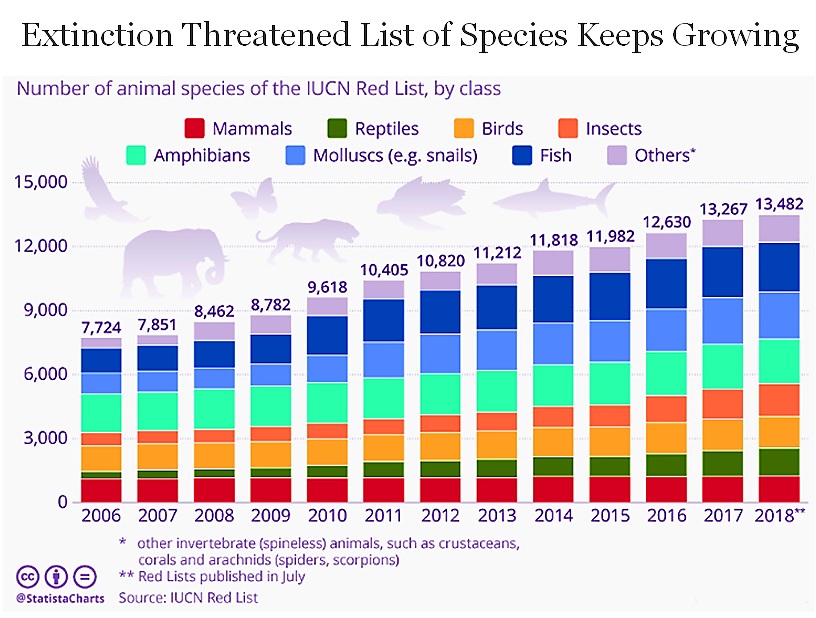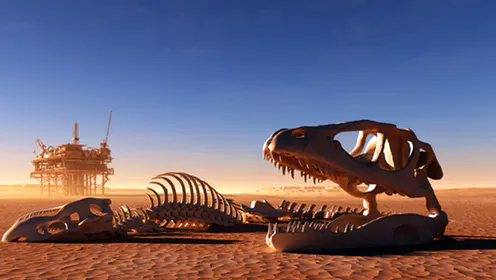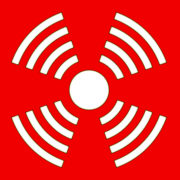The loss of biodiversity, the rise of deadly diseases
According to new research published in Nature, December 2019, a healthy biodiversity is essential to human health. As species (marine, terrestrial, and airborne) disappear, infectious diseases rise in humans and throughout the animal kingdom, so extinctions directly affect our health and chances for survival as a species. https://blogs.scientificamerican.com/extinction-countdown/humans-are-more-at-risk-from-diseases-as-biodiversity-disappears/
There are 26,500 species threatened with extinction, according to the International Union for Conservation of Nature (IUCN), a global network of some 16,000 scientists. That includes 40 percent of amphibian species, 33 percent of reef-building corals, 25 percent of mammals, and 14 percent of birds. Hawaii has had its share of extinctions, primarily birds, with over 50 species now extinct, and averaging one bird species going extinct every decade for the past 50 years.
https://en.wikipedia.org/wiki/List_of_extinct_animals_of_the_Hawaiian_Islands
Another indicator of a global biosystem in trouble is Earth’s insect species, essential to both the food chain of humans and animals alike — the total number and variety of insects is estimated to be dropping by 2.5 percent every year. “There are examples of species all over the world that are essentially the walking dead,” said biologist Paul Ehrlich.
Humans are more at risk from diseases as biodiversity disappears
“Biodiversity loss tends to increase pathogen transmission across a wide range of infectious disease systems,” Barnard College ecologist Felicia Keesing.
Pathogens can include viruses, bacteria and fungi. And humans are not the only ones at risk: all manner of other animal and plant species could be affected.
Biodiversity around the world is declining at a very fast pace.
The human population has swelled to over 7.5 billion and our species’ has produced a massive footprint on planet Earth with a devastating impact on mammals, birds, reptiles, insects, and marine life.
We’ve driven thousands of species to extinction through habitat loss, over-hunting and over-fishing, the introduction of invasive species into new ecosystems, toxic pollution, petro-chemical agricultural, and the overriding human-produced element: climate change in the form of global heating…
Only 3 percent of the original populations of the heavily fished Pacific bluefin tuna remain in the sea.

In the past 40 years alone, the number of wild animals has plunged 50 percent (2014 study). Just in the past 20 years, a 90 percent plunge in the number of monarch butterflies (an indicator species) in America, and an 87 percent loss of rusty-patched bumblebees. “We are sleepwalking toward the edge of a cliff,” said Mike Barrett, executive director at WWF.
The Holocene extinction, is otherwise referred to as the sixth mass extinction.
Is a global mass extinction now underway? Many scientists now believe humans are living through a “6th mass extinction,” or an epoch during which at least 75 percent of all species vanish from the planet.
The current and ongoing sixth extinction event of species (sometimes called Anthropocene) is the direct result of human activity. The current rate of extinction of species is estimated at 100 to 1,000 times higher than natural background rates.
In the Beginning…
Earth has supported life in some form for about 4.2 billion years. The previous five mass extinctions occurred over the past 450 million years; the last one occurred about 66 million years ago, when the aftermath of a massive asteroid strike wiped out the dinosaurs.
Prior global extinctions differed from the current one. They were triggered by a natural disaster or change in Earth’s climate. This time, it’s humanity that is driving a mass die-off with global consequences poorly understood or appreciated.
What are the consequences?
Potentially enormous. The loss of species can have catastrophic effects not only to the health of the planet, but to the food chain on which all of humanity depends. With widespread degradation of highly biodiverse habitats such as coral reefs and rainforests, as well as other areas, the vast majority of these extinctions are thought to be undocumented, as the species are undiscovered at the time of their extinction, or no one has yet discovered their extinction.
Ocean reefs, which sustain more than 25 percent of marine life, have declined by 50 percent already — and could be lost altogether by 2050.
Insects pollinate crops humans eat. Take the humble honeybee for example. U.S. Department of Agriculture’s National Agriculture Statistics Service finds that honey bees (in 2016 report) contributed over $339 million to the US economy in honey sales, but that’s just a drop in the bucket compared to the honey bee’s value to humans and our food chain.
In fact, bee pollination accounts for about $15 billion annually in added crop value; many crops are fully dependent on bee pollination which is vital to the approximately 250,000 species of flowering plants that depend on the transfer of pollen from flower anther to stigma to reproduce. Today, commercial agriculture production depends on more than 90 crops which rely exclusively on bee pollination.
Of the approximately 3,600 bee species that live in the U.S., the European honey bee (scientific name Apis mellifera) is the most common pollinator, making it the most important bee to domestic agriculture. Equally important to modern agricultural is the use of chemicals to manage so-called pests.
Introduced in 1990’s, Neonicotinoids, are now the most widely used insecticides in the world. Their benefits are widely marketed by chemical manufacturers, leading to their widespread use in agriculture and residential areas.
Studies have linked bee deaths and hive collapse to this relatively new form of insecticide due to its persistence in the soil, and ability to leach into the environment, high water solubility, with negative health implications for non-target organisms such as pollinators (honeybees).
Neonicotinoids can be sprayed onto foliage or applied as soil drenches, but they are predominantly used as seed treatments. When used this way, neonicotinoids are taken up by all parts of the plant as it grows. This means these systemic insecticides are present in pollen and nectar that pollinators can come in contact with when foraging. https://pollinator.cals.cornell.edu/threats-wild-and-managed-bees/pesticides/neonicotinoids/
About one-third of the food eaten by Americans comes from crops pollinated by honey bees, including apples, melons, cranberries, pumpkins, squash, broccoli, and almonds, to name just a few. Without the industrious honey bee, American dinner plates would look quite bare.
The current human-caused environmental stresses worldwide are …“far more than just being about losing the wonders of nature, desperately sad though that is,” the WWF’s Barrett said. “This is actually now jeopardizing the future of people. Nature is not ‘nice to have’ — it is our life-support system.”
Red Alert – deadly diseases on the rise
The rise in diseases and other pathogens seems to occur when so-called “buffer” species disappear. Co-author Richard Ostfeld of the Cary Institute of Ecosystem Studies points to the growing number of cases of Lyme disease in humans as an example of how this happens. The authors focused on diseases—including Lyme, West Nile virus, hantavirus and nine others—around the world. In each case they found that the maladies have become more prevalent during the time in which local biodiversity shrank.
“Preserving large intact areas and minimizing contact with wildlife would go a big step of the way to reducing disease,” Keesing said in Nature.
So should you care? Yes you should, if you value your health. Living in balance with nature not only makes sense, but it essential to all life (humans included) on Earth.
A healthy planet equals healthy humans …a lesson we humans must learn or join the 6th global extinction of species now underway.




Leave a Reply
Join the Community discussion now - your email address will not be published, remains secure and confidential. Mahalo.